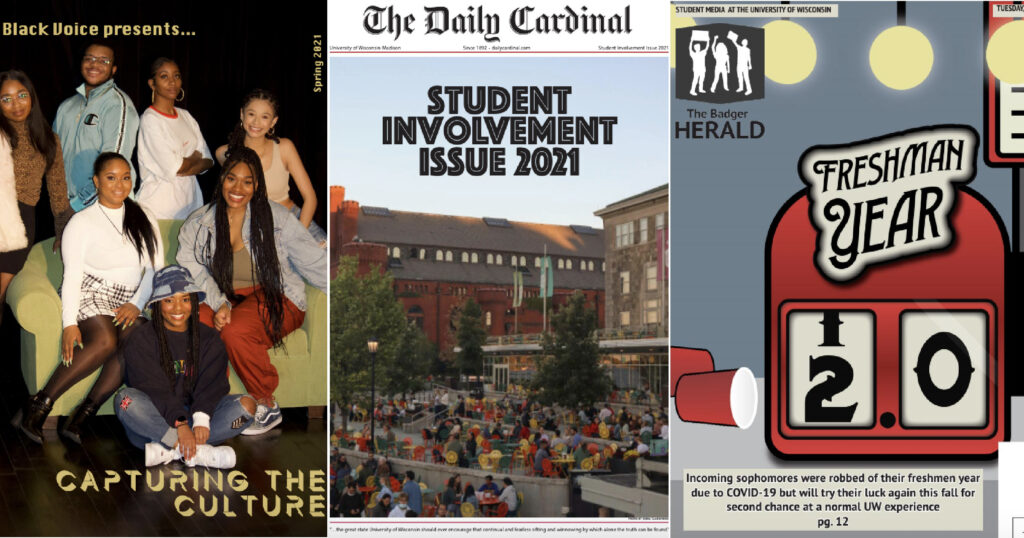
By Emily Knepple
As student organizations look ahead to a new year with more leniency surrounding in-person gatherings, many are tasked with deciding what that actually looks like for their group. For student publications in particular, the COVID-19 pandemic has changed past practices completely.
“It’s been a matter of first, how do we adjust what we’ve done in person to the pandemic? And now, how do we adjust that back to being in person?” said Grace Hodgman, managing editor of the Daily Cardinal.
At the onset of the pandemic, both the Daily Cardinal and The Badger Herald immediately halted in-person production. Both papers continued to strictly publish stories virtually throughout the 2020-21 school year, as well as conducted all meetings over Zoom.
Now, as vaccination rates on campus continue to rise, students can return to a slight sense of normalcy. Erin Gretzinger, who was elected editor-in-chief of The Badger Herald this past spring, shares that the past year and a half has made it obvious that you can create a newsroom online if necessary.
“There is an accessibility and flexibility component that comes with working virtually,” said Gretzinger. However, nothing can quite replace being in person and the sense of community that comes with it. “One of my goals is to re-foster that sense of what it means to be in person and all the learning opportunities that can come with that.”
At the Daily Cardinal, students share a similar sentiment. Editor-in-chief Addison Lathers admits that one of the goals of the paper is to return to the sort of community that came from long print nights and other group activities.
“When I came into this role, I wanted to make the paper something that people actively wanted to do. I wanted them to be excited to come in and put out new pieces,” said Lathers.
Lathers also spent the past few months reflecting on what she and the Cardinal team want out of this experience.
“I thought about, how much are we working for this paper? And how much should the paper be working for us?” said Lathers. This mindset has helped enable her to really lean into the camaraderie that the Cardinal continues to cultivate.
Both Lathers and Gretzinger shared that the past year and a half has also made their papers reconsider what it means to physically print and its feasibility.
“We realized how much money we can save,” admitted Gretzinger.
“How much did we want to print? The pandemic puts things in perspective, is it feasible?” echoed Lathers.
With a new perspective on spending, both papers have redefined their print schedules for the semester. At the Daily Cardinal, the paper will publish a physical copy on the last Thursday of every month. At the Badger Herald, they will print physically on the first Tuesday of each month.
This decision allows for each print issue to include more than it has in the past.
“Because of the money that we’re saving, we’re able to do a bigger and larger edition which gives more creative freedom to the other desks,” said Hodgman. “We’re also able to have more training, group activities, things along those lines because of that money we’re saving.”
The Daily Cardinal plans to theme each print issue, with the September 30 edition focused on student organizations and the return to campus.
At The Badger Herald, Gretzinger shares that the paper operates on a two-week cycle, with stories pitched at the beginning of one week and a deadline of the Monday after, with an anticipated run on Tuesday. This structure is set to continue this semester, with the only exception on the first Tuesday of the month, where those stories will be published in a physical copy of the paper.
“At the moment we are really focusing on upping the visual elements of our print editions in coordination with our graphics, photo and multimedia directors,” said Gretzinger.
For students all across campus, the pandemic has proved just how much we can do online. Gretzinger shares that the flexibility of the newsroom has proved to be important. Student journalists have now seen what can be done online to preserve the health of their team. “We’re balancing the flexible, remote aspect now more than ever,” shared Gretzinger.
Another student publication, The Black Voice, issued their first print edition in nearly 50 years at the end of the spring 2021 semester. Originally founded in 1971, The Black Voice published its last print issue in 1973. Revitalized in 2014, the group had previously published exclusively online. The print magazine, Capturing the Culture, marked 50 years since the organization’s founding, and covered a wide variety of topics from fashion and music to healthcare disparities and campus history.
“Capturing the Culture is a commemoration of the fierce grit, rare beauty and radiant glory we have embodied in this unforgettable year and will continue to fearlessly express,” said the 2020-21 editors of The Black Voice Nile Lansana (BA’21), Chelsea Hylton (BA’21) and Enjoyiana Nururdin (BA’21) in the magazine’s editors’ note. “As graduating seniors who have grown up in TBV, we are so happy with everything this publication as a whole has been able to accomplish.”
For all student media organizations, members are excited to get back in the newsroom and work with one another on potential stories. With a new outlook on what physical print means, and an eager and excited attitude towards in-person production, this semester proves to be an exciting one for student publications at UW-Madison.